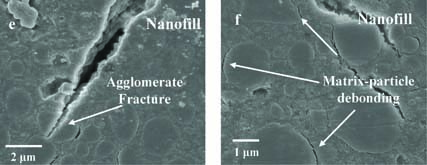Dental restorative materials must satisfy a diverse set of property requirements such as matching the optical/aesthetic appearance of tooth tissue, being geometrically stabile and biocompatible with the tooth tissue, along with having adequate strength, fracture toughness and fatigue resistance. While modern resin based dental restorative composites are excellent in their aesthetic properties, they often have shortcomings in the other areas that lead to premature failures, most commonly by secondary caries development or mechanical failure of the restoration. For posterior teeth, and depending on the restoration class, annual failure rates up to 15% and average restoration lifetimes less than 6 years have been reported. Generally, strategies are needed to improve the mechanical performance and secondary caries resistance without sacrificing the aesthetic properties. For mechanical performance, our laboratory has shown the approach of using a hierarchical structure of large reinforcements made from smaller nanoparticles shows promise. When compared to traditionally reinforced composites and natural hard tooth tissues, fracture toughness and fatigue crack growth experiments have demonstrated that the same toughening mechanisms of crack deflection and crack bridging can be achieved; however, challenges to improving mechanical performance have been identified as optimizing the microstructure morphology and getting adequate bonding of the nanoparticle agglomerate reinforcements to the resin matrix. To promote improved secondary caries resistance, composites containing bioactive glass (BAG) have been developed with the goal of providing a locally anti-bacterial environment to hinder biofilm growth while also providing ions to aid in remineralization of lost tooth tissue. BAG containing composites have been produced with adequate mechanical and aesthetic properties, and to assess their secondary caries resistance a first ever system has been designed and constructed to grow biofilms on restorations in human tooth tissue samples during in-situ cyclic mechanical loading. Recent results show reduced bacterial penetration into gaps at the tooth-restoration margin for BAG containing composites.
Research is funded by the National Institute of Dental and Craniofacial Research (NIDCR)
